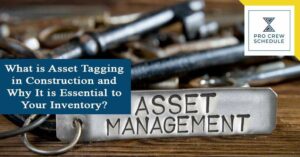As a contractor, you are always on the move, from one site to another, from job to job. And with so much shuffling around, there is more and more opportunity for human errors, especially in your inventory, like lack of materials, tools ending up on the wrong jobsite on the wrong day, etc. When you have your inventory tied up across multiple jobs, mistakes are easy to be made.
By 2022, everybody in the industry is expected to be tagging their construction assets, equipment, and overall inventory. So, have you made some changes already? In this blog, you will learn how to start a fool-proof asset tagging process and system.
The Role of Asset Tagging in the Construction Industry
Inventories in your business are a chockfull of items, big or small, that need to be tracked regularly. Knowing their functional conditions and current location is crucial when your company has thousands and hundreds of physical assets. Identifying, controlling, and monitoring your assets with asset tags is essential to your construction company’s bottom line.
In addition, online inventory software and control systems help you manage your physical capital, allowing you to make more informed decisions regarding physical inventory, like when to move and replace items. The role of asset of tagging in your business involves:
- Equipment tracking – asset tags are then used to track the assets wherever they move from manufacturing or construction site to lab. The purpose here is to dock or lab these assets for further distribution in all check-ins and check-outs.
- Inventory Control – asset tags can help perform periodic audits usually involved in your business, calculating the asset’s value over its lifecycle.
- Theft Prevention – The return of your valuable assets is vital. It is easier to return the useful instrument to the rightful owner with asset tagging, preventing accidental misplacements of the assets.
- MRO information – scanning your asset tags with the barcodes, in particular, can help you know more about the maintenance schedules and repair instructions.
Tracking all of your company assets and collecting data using asset tags has proven to be faster, more accurate, and less expensive than manual data collection. And with asset tags remaining readable despite faster environments, you can manage your physical assets and overall construction inventory without worrying that anything will dwindle.
Which Assets Your Company Should Tag?
The need to track assets typically comes from a different point of view. Some of your assets might be crucial to ensure the smooth run of your operations. So, if these assets tend to fail or are perhaps unavailable at the moment, there could be risks and some liabilities that are often monetary.
It is your job to make sure your assets do not get lost and stolen. Let us look at some of the most common ones.
- Construction Equipment, Tools, and Machines
There is a range of equipment and machines from the biggest to the smallest that get tagged. Construction equipment and tools like wrenches, hammers, screwdrivers and all power tools have to be tagged.
- Construction vehicles
Of course, your company uses many types of vehicles like front loaders, cranes, trenchers, graders, etc. This might not be a detailed list but tracking this kind of assets enables your business in assessing usage, reducing costs, and optimizing processes and expenses related to your company assets.
- Office Equipment
Personal devices provided to your crew members assigned in the office are subject to asset tagging. The tagged assets list includes desktops, laptops, TVs, tablets, conference equipment, and even mobile phones.
Your Step-by-Step Guide to Asset Tagging Process
No matter the size of your construction business, the ability to tag your assets and constantly track them is crucial to your overall inventory. Not only is asset tagging an effective method to determining the number of assets and stocks your company has, but it also allows your business to benefit in many ways.
So here is an essential guide of the asset tagging process that you can use for your business. Presently, the process can be broken down into simplified four steps:
1. Assigning a Unique Identification Number
Once the type and category of your asset have been highlighted by the time you purchased it, it is time to begin assigning a unique identification number. Each ID number is unique and will set all of your company assets apart from one another. These assets become instantly recognizable, especially on modern software solutions like web-based inventory software, which you should incorporate for better tracking and managing your assets.
As for sorting, you may want to pick a categorization method that aligns with the least to most commonly used tools and equipment onsite. Categorize your assets this way and make sure that your physical assets match your methodology. Depending on the number of your assets and stocks, the approach you will take may be different. Be strategic and make use of the right processes and reliable applications.
2. Choosing the Right Tags and Labels
When it comes to tagging construction assets, there are many options you can pick. However, it is crucial to realize that each of your asset tags has a unique characteristic. This only means a tag that might be suitable for one item might not be ideal for another. You have to consider whether to prioritize tags based upon certain conditions.
Asset tag options include:
- GPS trackers – despite the bleak statistics concerning construction equipment theft, you do have one advantage on your side, construction GPS tracking. GPS for construction equipment is somewhat a combination of software and hardware that you can use to track the locations of your most high-risk and valuable tools and equipment.
- RFID tags – RFID solutions are an easy way to keep track of which construction tools have been used and checked out and how long the tool was being used right after being checked back in.
- NFC trackers – In construction, NFC tags are used on bustling job sites to streamline everyday operations. These NFC readers are strategically placed around sites to track arrival time and whereabouts spontaneously.
- Barcodes – To have an accurate tracking system, barcodes are proven to be highly beneficial. Barcoding has become increasingly prevalent in the construction sector due to tracking materials, equipment, and tools.
- QR Codes – The success of barcodes led to the development of QR codes. Because of the storage and flexibility of QR codes, construction companies are using them to improve client experience and implement eco-friendly and sustainable business practices.
3. Creating an Asset Profile
When assigning tags, the correct data that matches the intended asset has to be included. Upon doing so, your business can create a detailed profile for every item that should exist and can be accessed by your construction inventory app. Having everything put in one central place will help record all necessary information which is imperative for tracking and inventory purposes.
And whenever you have new items onsite, you and your team can quickly execute a more profound examination. And at the same time, you may see that the item is nearing the end of its useful life and should not get a costly upgrade. As you may know, asset data generally includes the following:
- Manufacturer Details
- Date of purchase
- Serial numbers
- Condition
- Location
- Value
- Typical Usable Life
4. Affixing an Asset Tag
Once valuable construction equipment has been identified and an asset profile has been already created, you can now begin the process of tagging your other assets. And depending on the nature of your construction assets, you can input more information to maintain the records that essentially provide you with the right insights.
Overall, deploying a consistent asset tagging process ensures that all of the assets received by the company are regularly tracked and classified. Therefore, it will be easier for you and your team to locate assets, maintain accurate record-keeping, implement regular schedules and maintenances for inventory purposes.
Developing comprehensive procedures with clear policies and training your team members on asset tagging flow combined with proper construction inventory management can ultimately have a significant impact on your company’s bottom line. Your resource utilization improves, unnecessary duplication of assets is minimized, and you get more control of your assets and inventory.
Incorporate Your Asset Tagging Process with the Right Solutions
As your construction company relies heavily on physical assets, you must have the best ability to manage all your company assets accurately, efficiently, and in real-time. So, automating your asset tagging process and material requisition will help you control your material costs and optimize equipment spend.
Rigorous asset management processes, integrated and enabled by the right tools like Pro Crew Schedule, can make a huge difference in your projects’ profitability and the overall health of your construction business. Inventory management software like Pro Crew Schedule can accelerate your procurement process, helps control material costs, and boost operational performance – which are all specifically vital for self-performing contractors, heavy/civil contractors, and specialty contractors.
Get started with a 30-day FREE trial and experience what Pro Crew Schedule offers.
Key Takeaways
Investing in asset tags and inventory must be one of the many things you must consider when owning a construction business. One of the good reasons why it is a great idea to invest in asset tags is due to the fact that keeping track of a range of your assets can be tedious. This is also especially true if you do not set inventory software in the first place.







